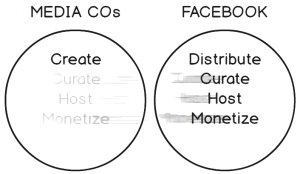Great series starting up in Recode from Tony Haile, founder and CEO of Chartbeat and an adjunct professor of media and technology at Columbia and Stanford Universities.
Digital media companies do five things. They create, host, curate, distribute and monetize content. Facebook now does four of them.
Normally this should not concern media companies more than any other competitor that they must face. However, Facebook’s mass acts as an an intense gravitational force in the industry, warping user behavior and fracturing the economic incentives that defined media companies. It suggests that those media companies that survive will view much of the infrastructure they possess today as just as much of a millstone as they did the printing press.…
Mobile traffic has surpassed 50 percent of traffic to media companies and is heading towards 60 percent to 70 percent. Mobile traffic is 3-4 times more likely to be from social sources than on desktop and that social traffic is more likely to be Facebook than Twitter by an order of magnitude. On mobile, for media, traffic increasingly = Facebook.
…
The biggest impact of this is that content that has been bundled together within a site is now atomized. Content used to be connected to each other by the strong force of user behavior and the weak force of brand. Users would come to a site, read a piece of content, and then go on to another.
Habit and ease were driving behavior that over time meant absorbing brand attributes and creating a sense of loyalty and self-identification. That connection is being severed.
…
Unfortunately, for many publishers the need for cost-cutting and helter-skelter attempts to compete technologically with the platforms means that they have invested more in what commoditizes them than what differentiates. The guardians of brand voice who were sub-editors were cut in favor of investing in new CMSes for sites that increasingly see their audience interact with their content elsewhere. Those few with strong distinctive brands can be thankful for the work already put in, those whose brands are too often interchangeable or indistinct face a hard road.
…
That doesn’t work on mobile. The argument for writing the uneconomic news piece that attracts the user to the site who will then go on to the lucrative real estate section is now moot. Those trying to make an economic case for the kind of content that is important for democracy but not for advertisers will find themselves on shifting sands.
Native advertising, the overladen vehicle upon which so many of publishers hopes now rest, faces the same challenges in an atomized content world. When working as intended, native advertising is commercial content intended to elicit the same user experience as the editorial content that surrounds it. In an atomized world, no editorial content surrounds it. It exists alone in the stream, adrift from the content it was intended to mimic.
With that unbundling, the only economic purpose for a site that makes its living from native advertising to create content other than native advertising is to maintain its brand. This means that the media company becomes a native advertising creative agency with an absurdly expensive brand marketing department formerly known as the newsroom.
Full version: http://www.recode.net/2016/5/9/11610100/the-facebook-papers-part-1-the-great-unbundling

